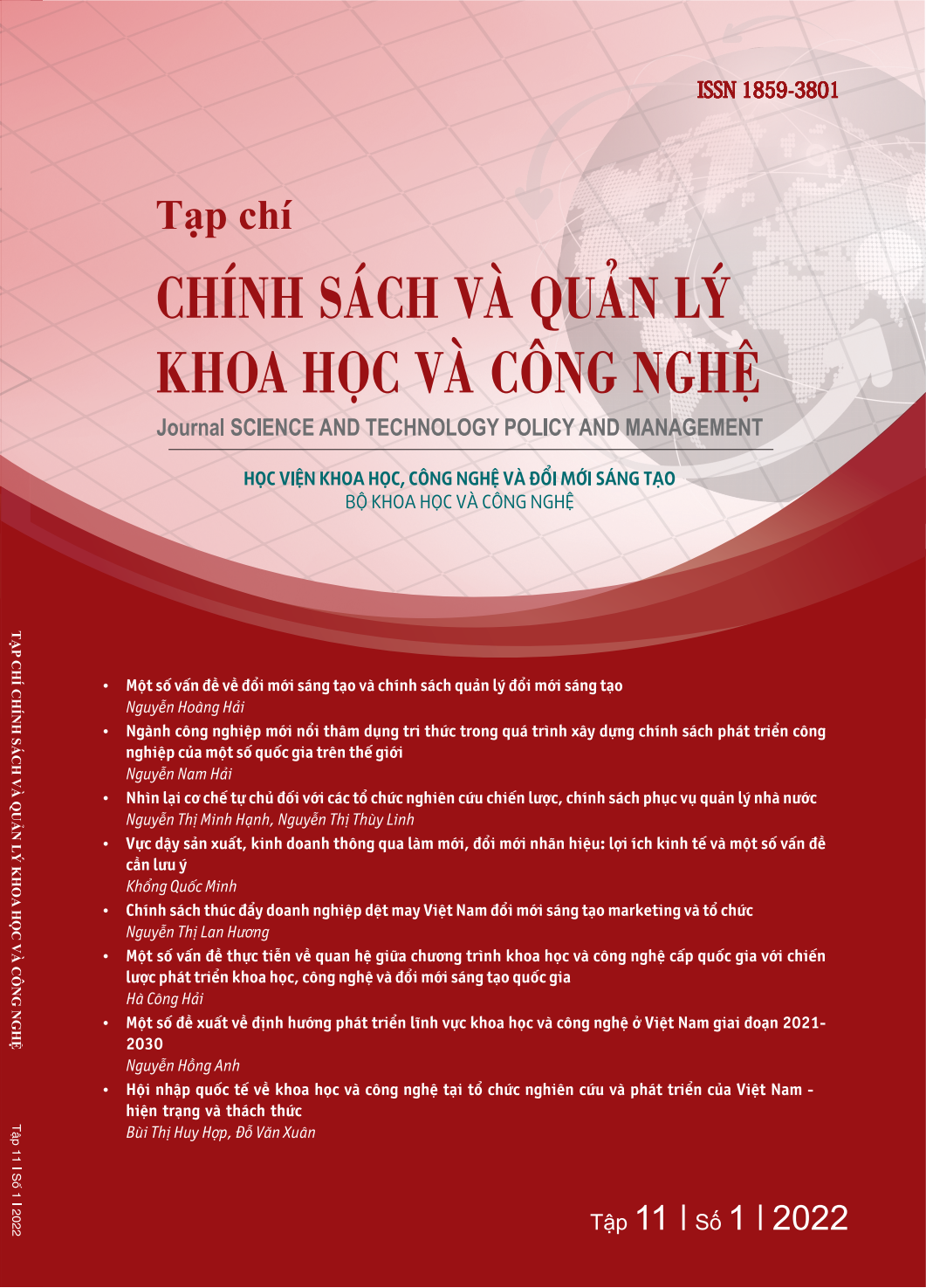Some issues on innovation and innovation management policies in Vietnam
Keywords:
Innovation, Evolution of innovation models, Government policy on innovation, Governance of innovationAbstract
Over the years, “innovation” has gradually become synonymous with the development of countries, technological progress and the driving force leading to business success. Today, innovation is not simply recognized as “creating something new” but also a solution and a way to solve many problems in economic development, improving people's quality of life and ensuring sustainable development goals. The term “innovation” is increasingly used by policymakers, marketing experts, and management consultants to imply more than just a strictly scientific concept but rather are decisions of government, political commitments or manifestos, a vision, a metaphor for a product or service that brings values and positive meanings to people's life. This article will provide some findings on the change in awareness and concept of innovation over the time and identify some contents that need to pay attention in the current government policy on management of innovation activities.
Code: 22043001
Downloads
References
Ahmed P.K., Shepherd C. (2010). Innovation management: context, strategies, systems and processes. Harlow: financial times prentice hall.
Bacon F.R., Butler T.W. (1998). Achieving planned innovation: a proven system for creating successful new products and services. New York: Free Press.
Beije, P. (1998). Technological change in the modern economy. Cheltenham: Edward Elgar.
Brettel M., Heinemann F., Engelen A., Neubauer S. (2011). “Cross-functional integration of R&D, marketing, and manufacturing in radical and incremental product innovations and its effects on project effectiveness and efficiency. Journal of Product Innovation and Management. Vol. 28, No. 2, pp. 251-269.
Dakhli M., De Clercq D. (2004). “Human Capital, Social Capital, and Innovation: A Multi-Country Study”. Entrepreneurship and Regional Development, Vol. 16, No. 2 pp. 107-128.
Dodgson, M. & Bessant, J. (1996). Effective innovation policy: A new approach. London: International Thomson Business Press.
Drucker P. F. (1985). Innovation and Entrepreneurship. Heinemann, London.
Freeman, C. (1991). “Networks of innovators: A synthesis of research issues”. Research Policy, 20, 499-514.
Godin B. (2008). “Innovation: the History of a Category”. Working Paper No. 1, Project on the Intellectual History of Innovation, Montreal: INRS. 62 p
Hobday, M. (1991). “Dynamic networks, technology diffusion and Complementary assets: Explaining U.S. decline in semiconductors”. DRC Discussion Papers, 78. Falmer, U.K.: Science Policy Research Unit, University of Sussex.
Kline S. J., Rosenberg N. (1986). “An Overview of Innovation”. In: Landau R., Rosenberg N. (Eds). The Positive Sum Strategy. Washington, D.C.: National Academy Press, pp.275-305.
Lee, K. (2013). Capability failure and industrial policy to move beyond the middle-income trap: from tradebased to technology-based specialization. In Stiglitz, J. E., Lin, J. Y., & Patel, E. eds. The industrial policy revolution. Palgrave Macmillan. London.
Linton J. 2002. “Implementation Research: State of The Art and Future Directions”. Technovation,Vol. 22, No. 2, pp. 65-79
Lundvall, B. (1992). National systems of innovation: Towards a theory of innovation and interactive learning. London: Pinter
Metcalfe, S. (1995). “The economic foundations of technology policy: Equilibrium and evolutionary perspective”. In: P. Stoneman (Ed.), Handbook of the Economics of Innovation and Technological Change (pp. 409-512). London: Blackwell.
Nelson, R. (2000). “National innovation systems”. In: Z. Acs (Ed.), Regional Innovation, Knowledge and Global Change (pp. 11-26). London: Pinter.
OECD (1981). The Measurement of Scientific and Technical Activities. Paris, OECD.
OECD (1999). Managing national innovation systems. Paris: OECD.
OECD (2005). Oslo Manuals. Guidelines for Collecting and Interpreting Innovation Data, 3rd edition // OECD, Paris
OECD (2008). Review of Innovation Policy: China. Paris.
OECD (2009). Review of Innovation Policy: Korea. Paris.
OECD (2014). Science, Technology and Industry Outlook 2012. Paris.
O'Sullivan D., Dooley L. (2009). Applying Innovation. Sage Publications, Inc.
Ram J., Cui B., Wu M.L. (2010). “The Conceptual Dimensions of Innovation: A Literature Review”. Proceedings of the International Conference on Business and Information, Sapporo, Japan, 3rd-5th July, 2010.
Rasul F. (2003). The Practice of Innovation-Seven Canadian Firms in Profile. Industry Canada
Rogers E.M. (2003). Diffusion of Innovation (5th Ed.). New York, NY 10020: The Free Press.
Rothwell R., Zegveld (1985). Reindustrialization and Technology. Harlow, U.K.: Longman.
Sako, M. (1992). Price, quality and trust: How Japanese and British companies manage buyer supplier relations. Cambridge: Cambridge University Press.
Schumpeter J.A. (1939). Business Cycles: A Theoretical, Historical, and Statistical Analysis of the Capitalist Process. New York: McGraw-Hill.
Strambach S. (2002). “Change in the Innovation Process: New Knowledge Production and Competitive Cities-The Case of Stuttgart”. European Planning Studies, Vol. 10, No. 2, pp. 214-231.
Walker R. (2006). “Innovation Type and Diffusion: an Empirical analysis of Local
Government”. Public Administration, Vol. 84, No. 2. 311-335.
Wang C., Kafouros M. (2009). “What Factors Determine Innovation Performance in Emerging Economies? Evidence from China”. International Business Review, Vol. 6, No. 6, pp. 606-616.
Zaltman G., Duncan R., Holbek J. (1973). Innovations and Organizations. John Wiley & Sons, Inc
Downloads
Published
How to Cite
Issue
Section
License
Authors who publish with this journal agree to the following terms:
- Authors retain copyright and grant the journal right of first publication with the work simultaneously licensed under a Creative Commons Attribution License that allows others to share the work with an acknowledgement of the work's authorship and initial publication in this journal.
- Authors are able to enter into separate, additional contractual arrangements for the non-exclusive distribution of the journal's published version of the work (e.g., post it to an institutional repository or publish it in a book), with an acknowledgement of its initial publication in this journal.
- Authors are permitted and encouraged to post their work online (e.g., in institutional repositories or on their website) prior to and during the submission process, as it can lead to productive exchanges, as well as earlier and greater citation of published work (See The Effect of Open Access).

